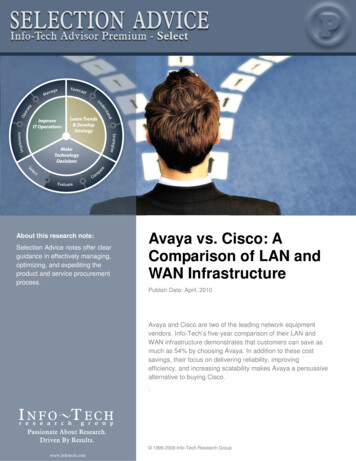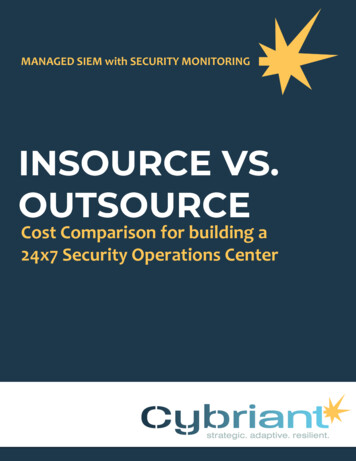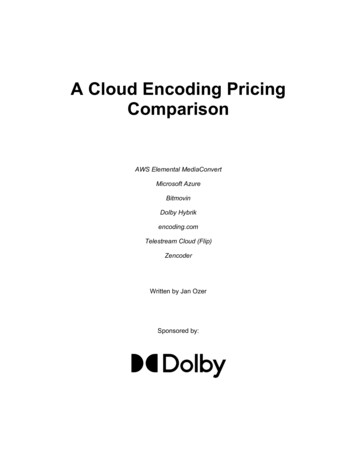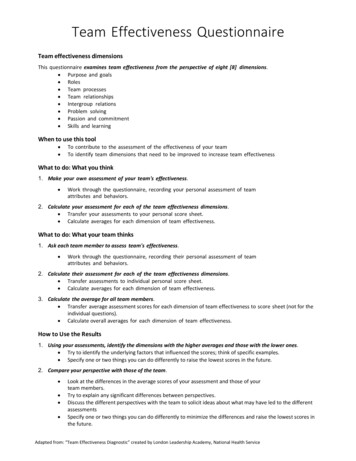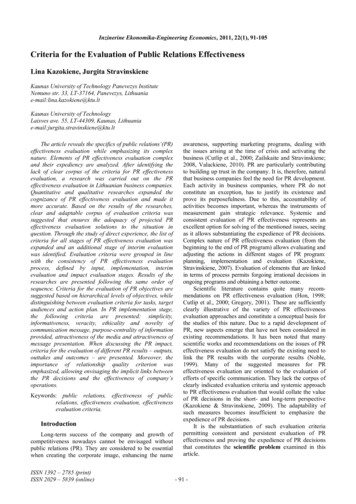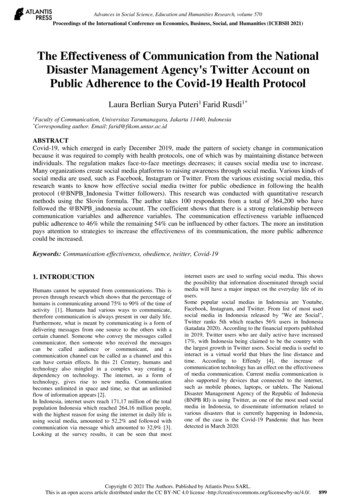
Transcription
View metadata, citation and similar papers at core.ac.ukbrought to you byCOREprovided by Elsevier - Publisher ConnectorClinical Therapeutics/Volume 36, Number 12, 2014Comparison of the Cost-effectiveness of New OralAnticoagulants for the Prevention of Stroke and SystemicEmbolism in Atrial Fibrillation in a UK SettingYing Zheng, MS, MHSA1; Sonja V. Sorensen, MPH1; Ann-Katrin Gonschior, PhD2;Herbert Noack, PhD3; Jutta Heinrich-Nols, MD3; Tom Sunderland, MSc4; andAnuraag R. Kansal, PhD11Evidera, Bethesda, Maryland; 2Boehringer Ingelheim GmbH, Ingelheim am Rhein, Germany; 3BoehringerIngelheim Pharma GmbH &Co KG, Ingelheim am Rhein, Germany; and 4Boehringer Ingelheim Ltd,Berkshire, United KingdomABSTRACTPurpose: Three new oral anticoagulants (NOACs)have recently become available in the United Kingdom asan alternative to warfarin in the prevention of stroke andsystemic embolism in atrial fibrillation. This study examines the relative cost-effectiveness of dabigatran (BIDdosing of 150 mg or 110 mg based on patient age),rivaroxaban, and apixaban from a UK payer perspective.Methods: A previously published model that followsup patients through treatment of atrial fibrillationduring a lifetime was adapted to allow comparison ofthe 3 NOACs and warfarin. Acute thromboembolic andbleeding events, as well as long-term consequences ofstroke, intracranial hemorrhage, and acute myocardialinfarction, were tracked. Relative efficacy was calculated from a formal indirect treatment comparison usingdata from the 3 key trials (Randomized Evaluation ofLong-Term Anticoagulation Therapy, RivaroxabanOnce-daily oral direct factor Xa inhibition Comparedwith vitamin K antagonism for prevention of stroke andEmbolism Trial in Atrial Fibrillation, and Apixaban forthe Prevention of Stroke in Subjects With AtrialFibrillation) of the NOACs. Data from the rivaroxabantrial were adjusted for the difference in internationalnormalized ratio control among warfarin patients versus the other 2 trials. Model outputs included totalcosts, event rates, and quality-adjusted life-years.Findings: Among the patients taking NOACs, thosetaking dabigatran had the highest total QALYs (7.68QALYs), followed by apixaban (7.63 QALYs) andrivaroxaban (7.47 QALYs). Patients taking dabigatranhad the lowest total lifetime costs ( 23,342), followed byapixaban ( 24,014) and rivaroxaban ( 25,220). Thedifferences between dabigatran and apixaban wereDecember 2014modest but consistent in sensitivity analyses, with thedirectionality only changing at the limits of the CIs for therelative risks of ischemic stroke or intracranial hemorrhage or when assuming that both treatment discontinuation and post-event disability rates differ by drug.Implications: Dabigatran was found to be economically dominant over rivaroxaban and apixaban in theUK setting. These economic findings are based onrelative clinical efficacy from an indirect treatmentcomparison and would benefit from any data of directcomparisons of the NOACs in the future. (Clin Ther.2014;36:2015–2028) & 2014 The Authors. Publishedby Elsevier HS Journals, Inc.Key words: anticoagulation, apixaban, atrial fibrillation, cost-effectiveness, dabigatran, rivaroxaban.INTRODUCTIONAtrial fibrillation (AF) is the most common cardiacarrhythmia and the leading cause of stroke in theUnited Kingdom and across Europe.1 In patients withAF, 80% of ischemic stroke (IS) events result in deathor disability and 1-year mortality approaches 50%.2,3Vitamin K antagonists, such as warfarin, can behighly effective in preventing stroke in patients withAF. However, vitamin K antagonists are challengingto use in clinical practice because they produce highvariability in dose responses because of genetic andAccepted for publication September 17, .0150149-2918/ - see front matter& 2014 The Authors. Published by Elsevier HS Journals, Inc. This is anopen access article under the CC BY-NC-ND nd/3.0/).2015
Clinical Therapeuticsother factors and are subject to numerous food anddrug interactions, resulting in the need for intensivelaboratory monitoring.4 These issues had considerablylimited initiation and subsequent persistence withvitamin K antagonist treatment among AF patientsin the United Kingdom.5Recently, new oral anticoagulants (NOACs), classified as direct thrombin inhibitors (dabigatran etexilate) and factor Xa inhibitors (rivaroxaban andapixaban), have been approved and recommendedfor treatment of AF in the United Kingdom.6–8Evidence suggests that NOACs are at least as effectiveas warfarin for the prevention of stroke and systemicembolism in patients with AF and have a morefavorable profile regarding fatal and major bleeding.9Three Phase III trials evaluated the clinical efficacyand tolerability of dabigatran 150 mg BID and 110mg BID (Randomized Evaluation of Long-Term Anticoagulation Therapy [RE-LY]), apixaban (Apixabanfor the Prevention of Stroke in Subjects With AtrialFibrillation [ARISTOTLE]), and rivaroxaban (Rivaroxaban Once-daily oral direct factor Xa inhibitionCompared with vitamin K antagonism for preventionof stroke and Embolism Trial in Atrial Fibrillation[ROCKET-AF]) during a median follow-up period of2 years. These trials indicated superiority of dabigatran 150 mg (1.11% vs 1.71% per year; P o0.001)10,11 and apixaban (1.27% vs 1.60% per year;P .01)12 and noninferiority of dabigatran 110 mg(1.54% vs 1.71% per year; P ¼ .30)10,11 andrivaroxaban (2.1% vs 2.4% per year; P .12)13versus dose-adjusted warfarin on the primary outcomeof stroke or systemic embolism. Apixaban and dabigatran 110 mg also had an effect on major bleedingversus dose-adjusted warfarin, with a relative risk(RR) reduction of 0.69 (P o 0.001) and 0.80 (P ¼0.003), respectively.12With 3 NOACs approved and reimbursed in theUnited Kingdom, there is an increasing interest amongvarious stakeholders to understand the relative clinicalefficacy and cost-effectiveness among them. Althoughthe long-term clinical and cost-effectiveness of theseNOACs versus standard of care (including aspirin andno treatment) or dose-adjusted warfarin has beenassessed by several studies using simulation modelsin the UK setting, similar studies comparing all theNOACs are limited. The present study aims to addressthis knowledge gap. The relative clinical efficacy ofdabigatran, rivaroxaban, and apixaban was evaluated2016through an indirect treatment comparison (ITC),where the differences among the trial population werestatistically adjusted to the RE-LY trial population. Acost-effectiveness model was developed based on apreviously published framework to assess the relativebenefit of the treatments during patients’ lifetimes.METHODSModel DesignA Markov model with 3-month model cycles wasused to simulate patients with AF starting treatmentand followed up for their lifetime from the perspectiveof the UK National Health Service, considering directcosts only. Both cost and health outcomes werediscounted at 3.5% per annum in the model’s basecase, as recommended by the National Institute ofHealth and Care Excellence (NICE).14 Dabigatrandosing in the model corresponded to the approvedUK dosing, in which patients switch from the 150 mgBID dose to the 110 mg BID dose on reaching age 80years. Similarly, the approved UK dosing for apixaban(5 mg BID) and rivaroxaban (20 mg once daily) wasused in the model, and the effect of dose reduction incertain populations (eg, impaired renal function) wasassumed to be captured implicitly within the trial data.Model StructureThe current model expanded on a previouslypublished model.15,16 The clinical events consideredincluded primary and recurrent IS, systemic embolism,acute myocardial infarction (AMI), transient ischemicattack (TIA), intracranial hemorrhage (ICH) (including hemorrhagic stroke [HS] and major extracranialhemorrhage [ECH]), minor bleeding, and death. TheIS risk was stratified by patients’ CHADS2 score17(Congestive heart failure, Hypertension, Age 475years, Diabetes, and prior Stroke) and stroke historyin each model cycle. As in the previously publishedmodel, nonfatal IS and ICH can result in disability(independent, moderately dependent, or totallydependent) based on the post-event modified RankinScore for IS and the Glasgow Outcome Scale forICH.18 The previous model was updated to considerthe effect of AMI history, which would increase therisk of future AMI19 and also result in long-termquality of life and cost effects.Volume 36 Number 12
Y. Zheng et al.Clinical InputsThe base case patient population in this modelreflected the RE-LY population characteristics.10 Themean age of the patient population at model entry was71 years, among whom 63.6% were male and 16.6%had a history of AMI. Baseline CHADS2 scoredistribution is presented in Table I, and all patientsentered the model as independent in terms ofdisability level.The warfarin arm of the RE-LY trial was used asthe reference arm for clinical event risks. The eventrates for other comparators were derived by applyinga RR to the warfarin rates. Clinical events weredefined fairly consistently across the 3 major trials.The RR was computed through an ITC using amethod published by Bucher et al,20 in which doseadjusted warfarin was used as a common comparatoramong all 3 clinical trials (details of the ITC areavailable in the Supplemental Appendix in the onlineversion at . To match the approved indication in theUnited Kingdom, the dabigatran data included inthese analyses combined data from the 2 RE-LYdabigatran treatment arms, based on patient age atrandomization, to form a single dabigatran treatmentgroup. Specifically, this set (n ¼ 5990) combinedpatients aged o80 years from the dabigatran 150 mgBID group (n ¼ 5019/6076) and patients aged Z80years from the dabigatran 110 mg BID group(n ¼ 971/6015) (Boehringer Ingelheim, data on file).Table I. Patient Baseline CHADS2 Score Distribution and Stroke HistoryCHADS2Score0123456CHADS2Distribution, %PreviousStroke, %2.529.435.620.28.92.90.50063781100100CHADS2 ¼ Congestive heart failure, Hypertension, Age475 years, Diabetes, and prior Stroke.17December 2014Because the patient age, CHADS2 score, and international normalized ratio (INR) control were similarbetween the RE-LY population and the ARISTOTLEpopulation, no adjustment for these characteristicswas needed in the ITC. However, the ROCKET-AFpopulation was on average older, had higherCHADS2 scores, and achieved worse INR controlcompared with the RE-LY population. The meantime in therapeutic range (TTR) in the warfarin armsof the RE-LY and ARISTOTLE trials was similar(64.4% and 62.2%, respectively), but it was worsefor the ROCKET-AF trial (55.2%). Given that poorINR control was associated with higher risk ofclinical events,21 it was necessary to adjust theROCKET-AF estimates of events in the warfarinarm, and thus the RR of events between rivaroxabanand warfarin, to account for this difference in TTR.The difference in TTR between the warfarin arms ofthe RE-LY and ROCKET-AF trials were taken froman analysis conducted by the Division of Biometricsof the Food and Drug Administration in which theROCKET-AF trial population was adjusted by demographic, disease-related, and geographic factors tothe RE-LY population, leaving a residual differencein TTR of 6.7%.22 To adjust for the remainingdifference in the TTR, an adjustment factor wasapplied to the event rate in the warfarin arm of theROCKET-AF trial. The methods followed for making the TTR adjustment have been described previously.23 Briefly, the event rates for each type ofclinical event in the warfarin arm of the ROCKETAF trial were calculated. Each event rate for thewarfarin arm was then adjusted to account for the6.7% difference in TTR by applying an odds ratiofor every 10% difference in TTR, which was estimated using logistic regression of the warfarin arm inthe RE-LY trial as presented previously.23 Finally,the adjusted RR of rivaroxaban versus warfarin wascalculated by dividing the event rate in the ROCKETAF rivaroxaban arm by the corresponding adjustedevent rate from the warfarin arm. The ITC wasconducted for the safety-on-treatment (SOT) population when data were available; otherwise (TIA,AMI, and minor bleeding) intent-to-treat data wereused. The ARISTOTLE trial reported the compositeevent rate for stroke or systemic embolism in theSOT population but not the individual event rate forIS and systemic embolism, respectively.24 The eventrates were derived for these 2 events from the2017
Clinical Therapeuticscomposite event rate, assuming that the eventcomposition in the SOT population was the sameas in the intent-to-treat population.12 The clinicalevent rates for the reference arm and the results ofthe ITC are summarized in Table II.The ICH events resulted in discontinuation ofcurrent treatment. Patients could also discontinuefor other reasons, including ECH and nonclinicalreasons such as patient’s decision. Treatment discontinuation for all comparators was modeled usinga Weibull function that estimated 14% discontinuation in 1 year and 21% discontinuation in 2 years,closely replicating the RE-LY trial outcome. Although the proportion of patients reported to discontinue treatment in the Phase III trials were different (21% for dabigatran vs 17% for warfarin, 24%for rivaroxaban vs 22% for warfarin, and 25% forapixaban vs 28% for warfarin within approximately2 years of follow-up), the differences in trial designmade it infeasible to perform a cross-trial comparison, so all NOAC treatments were assumed to havea 21% discontinuation rate by the end of the secondyear.10,12,13 All patients who discontinued anticoagulant therapy for other reasons were assumed toswitch to aspirin, and patients who discontinuedaspirin therapy were assumed to permanently discontinue all treatment. The event risks while patientswere receiving aspirin therapy or no treatment werederived by applying RRs25 to the warfarin event rate(Table II). Patients remain subject to short-term eventcosts and long-term disability costs after switching toaspirin therapy or no treatment.Both ICH and IS can be disabling or fatal events.On the basis of the NICE Evidence Review Groupreport on a recent manufacturer submission of aNOAC,26 it was assumed that the post-eventoutcome for ICH and IS was not affected by theselection of treatment. On the basis of the RE-LY trial,4.3% of the patients were totally dependent, 19.7%were moderately dependent, 53.9% were independentafter IS events, and the rest experienced fatal events.Post ICH events, 31.8% of the patients were totallydependent, 8.8% were moderately dependent, 7.8%were independent, and the rest experienced fatalevents.Clinical events in this model can be fatal with theexception of TIA and minor bleeding. In addition tothe post-event mortality, the UK population background mortality (adjusted to avoid double-counting)2018was also applied to the model population. Patientswith a moderate to totally dependent disability levelwere assumed to have double the backgroundmortality.27Cost InputsDabigatran (110 mg and 150 mg) and apixabanwere priced at 65.90 per 30-day supply, whereasrivaroxaban was priced at 63.00 per 30-day supply.28The 30-day drug costs of warfarin and aspirin were 1.06 and 1.89, respectively, but warfarin patientsincurred an additional 38 monitoring cost monthly.6Event costs were assigned as per-episode costs thatvaried based on the disability level resulting from theevent where relevant. These costs were sourced eitherfrom a population-based study of UK AF patientcosts29 or from the dabigatran NICE submission.6Ongoing follow-up costs of disability management forpatients who were independent but with a history ofstroke, moderately disabled, or totally dependent wereset at 844, 4063, and 7587, respectively.29 Patientswith AMI history incurred an additional 20 cost everymodel cycle based on the apixaban NICE submission.7Discontinuation without an event incurred a cost of 44 based on the cost of one visit to a generalpractitioner.30 All cost inputs (Table III) are in 2013pounds, and costs not originally reported in 2013pounds have been adjusted for inflation according theinflation index from the Personal Social ServiceResearch Unit.31Utility InputsPatient survival was adjusted to account forquality-of-life effects using utility values. Healthstate utility and quality-of-life decrements for clinicalevents were based on previously published values forthe UK setting.16 The baseline utility of a populationwith AF was 0.81.32 A utility decrement was appliedat the time of an event for one cycle: stroke (utilitydecrement, 0.139), systemic embolism (utilitydecrement, 0.120), ICH (utility decrement, 0.181),ECH (utility decrement, 0.181), TIA (utilitydecrement, 0.103), AMI (utility decrement, 0.125),and minor bleeding (utility decrement, 0.004).32Utility values corresponding to patient‘s disabilitystatus were applied to all cycles in which patientsspent in that status: independent with stroke history(utility value, 0.76), moderately dependent (utilityvalue, 0.39), and totally dependent (utility value,Volume 36 Number 12
December 2014Table II. Baseline Event Risk and Relative Treatment EfficacyAnnualRisk forWarfarin, %IS (including uncertainstroke) by CHADS2score0123–45–6Systemic embolismTIAICH (including HS)ECHMinor bleedsAMIRelative risk of AMIhistory on 0.643.11Relative Risk (95% CI) vs WarfarinDabigatranRivaroxabanApixabanAspirinNo Treatment0.71 (0.53–0.96)*0.95 (0.76–1.18)*0.80 (0.65–1.00)*1.62 (0.99–2.65)3.35 (2.23–5.03)0.26 (0.10–0.71)0.76 (0.62–0.86)Assumed to be the same as dabigatran0.72 (0.51–1.01)0.42 (0.30–0.58)1.21 (1.04–1.41)0.79 (0.68–0.93)Assumed to be the same as dabigatran0.94 (0.73–1.22)0.88 (0.66–1.17)1.77 (0.66–4.77)1.56 (0.86–2.83)0.51 (0.16–1.60)1.14 (0.47–2.73)0.63 (0.32–1.22)1.42 (0.84–2.39)4.44 (1.78–11.08)1.23 (0.59–2.58)1.23 (0.59–2.58)0.61 (0.10–3.78)0.55 (0.38–0.80)1.57 (0.67–3.69)0.55 (0.25–1.24)0.79 (0.59–1.07)0.28 (0.17–0.45)1.07 (0.91–1.26)0.87 (0.82–0.93)1.28 (0.95–1.74)2019Y. Zheng et al.AMI ¼ acute myocardial infarction; CHADS2 ¼ Congestive heart failure, Hypertension, Age 475 years, Diabetes, and prior Stroke17; ECH ¼ extracranial hemorrhage;HS ¼ hemorrhagic stroke; ICH ¼ intracranial hemorrhage; IS ¼ ischemic stroke; TIA ¼ transient ischemic attack.*None of the Phase III trials studied whether the relative risk of IS for new oral anticoagulants was dependent or independent of CHADS2 score, and they were notpowered to determine the association. The Phase III trials for dabigatran10 and apixaban12 explored whether the primary efficacy end point (relative risk of stroke andsystemic embolism) was dependent on CHADS2 score, and both found the interaction statistically nonsignificant.
Clinical TherapeuticsTable III. Model Cost Inputs2013 Costs, Drug costs per itoring cost per yearWarfarinEvent cost per episodeFatal ISIS, independentIS, moderately dependentIS, totally dependentSystemic embolism, fatalSystemic embolism, nonfatalTIAICH, fatalICH, independentICH, moderately dependentICH, totally dependentECH (nonbrain), fatalECH (nonbrain), nonfatal, nongastrointestinalECH (nonbrain), nonfatal, gastrointestinalMinor bleedingAMI, fatalAMI, nonfatalFollow-up cost per quarterIndependent with stroke historyModerately dependent with stroke historyTotally dependent with stroke historyAMI historyOne-time discontinuation costAll 2313.931748.8992.163243.243243.24292929296*6*Data on .95292929744.0530AMI ¼ acute myocardial infarction; ECH ¼ extracranial hemorrhage; ICH ¼ intracranial hemorrhage; IS ¼ ischemic stroke;TIA ¼ transient ischemic attack.*Mean is an assumption from the manufacturer submission to the National Institute of Health and Care Excellence as part ofTA249, 2009/2010 cost inflated to 2012/2013. SE is assumed 20% of mean.†UK Cost of Stroke Study based on OXVASC. The 2008/2009 cost inflated to 2012/2013 by the inflation factor of 1.10.0.11).33 In addition, a long-term utility effect ofAMI history was considered in the model, with adisutility of 0.037 applied to patients with AMIhistory.342020Model AnalysesThe base case analyses compared clinical andcost-effectiveness of the 3 NOACs—dabigatran, apixaban, rivaroxaban—and warfarin. An incremental cost-Volume 36 Number 12
Y. Zheng et al.effectiveness ratio (ICER) was used to measure costeffectiveness; ICER compares the additional cost of atreatment to the incremental clinical benefit. A netmonetary benefit (NMB) analysis35 was also conductedthat converts clinical outcomes to monetary valuesbased on willingness-to-pay (WTP) for the gain ofone additional unit of health benefit, such as life-year(LY) or quality-adjust life-year (QALY), with a higherNMB indicating greater cost-effectiveness. Differentmodel parameters were tested in 1-way deterministicsensitivity analyses. Finally, a probabilistic sensitivityanalysis (PSA) was undertaken, varying all clinical,cost, and utility parameters in the model simultaneously, including all 3 NOACs and warfarin.RESULTSBase-Case AnalysisIn the base case for a lifetime analysis (Table IV),the patients treated with dabigatran experienced thelowest mean number of IS and ICH events per 100patient-years among the 3 NOACs. Patients takingrivaroxaban had the fewest systemic embolismevents, whereas patients taking apixaban had thelowest AMI rate. Patients treated with NOACs generally experienced fewer events compared with patients taking warfarin, with some exceptions.Compared with patients taking warfarin, patientstaking rivaroxaban and dabigatran had higher ECHrates, and patients taking dabigatran had a slightlyhigher AMI rate.Table IV presents mean total costs and disaggregated costs, total LYs, QALYs, and incrementalcost per QALY gained (ie, ICER) per AF patientcomparing dabigatran to rivaroxaban and apixaban.Despite slightly higher drug acquisition costscompared with the other NOACs, dabigatran’s totallifetime costs ( 23,342) were lower than those forrivaroxaban ( 25,220) and apixaban ( 24,014)Table IV. Deterministic Model OutcomesComparatorDabigatranClinical Events (per 100 Patient-years)IS2.33Systemic embolism0.23ICH (including HS)0.50TIA1.15ECH4.09AMI1.192013 Costs, Drug costs5669Event costs3237Follow-up costs14,436Total costs23,342LYs10.04QALYs7.68Incremental (Dabigatran vs Comparators)Total costs, LYsQALYsICERs (costs per 0149.977.63153434420,18424,6809.737.36 18770.200.21Dabigatran isdominant 6720.060.05Dabigatran isdominant 13380.300.32Dabigatran isdominantAMI ¼ acute myocardial infarction; ECH ¼ extracranial hemorrhage; HS ¼ hemorrhagic stroke; ICER ¼ incremental costeffectiveness ratio; ICH ¼ intracranial hemorrhage; IS ¼ ischemic stroke; LY ¼ life-year; QALY ¼ quality-adjusted life-year;TIA ¼ transient ischemic attack.December 20142021
Clinical Therapeuticsbecause dabigatran’s cost offsets were associated withreduction in events and long-term disability. Treatment with dabigatran also resulted in more QALYs(7.68 QALYs) compared with rivaroxaban (7.47QALYs) and apixaban (7.63 QALYs) and more LYs(10.04 LYs) compared with rivaroxaban (9.83 LYs)and apixaban (9.97 LYs). Thus, in the base case,dabigatran dominated both rivaroxaban and apixaban, yielding more QALYs at less cost.The incremental NMBs of dabigatran, rivaroxaban, apixaban, and warfarin were compared.At every WTP threshold, dabigatran had the highest incremental NMB (Figure 1). At the NICEWTP threshold of 25,000 per QALY, theincremental NMB versus warfarin was 9217 fordabigatran, 7203 for apixaban, and 2100 forrivaroxaban.NMB ranged from 4630 to 8943 for dabigatranversus rivaroxaban and from 474 to 3839 fordabigatran versus apixaban. Similarly, varying theRR of ICH from the upper to lower limits of the95% CI, the NMB for dabigatran versus rivaroxaban ranged from 5049 to 8479 and from 55to 3375 for dabigatran versus apixaban. Themodel NMB results were relatively robust to thevariations in the RR of ECH, AMI, and the longterm utility of AMI history. The NMB accruedrelatively steadily over time, with higher NMBs forlonger time horizons. The NMB of dabigatranversus rivaroxaban was 1290 under a 5-year timehorizon and 3319 under a 10-year time horizon.The NMB of dabigatran versus apixaban was 239under a 5-year time horizon and 815 under a 10year time horizon. The model outcome is slightlymore favorable for dabigatran when 150 mg BIDdosing (the approved dosing for dabigatran incertain markets, including the United States) is usedinstead of the approved dosing in the EuropeanUnion, with an NMB of 7256 versus rivaroxabanand 2152 versus apixaban. In all sensitivity analyses performed, dabigatran had a positive NMB at aWTP of 25,000 per QALY compared with rivaroxaban. Compared with apixaban, dabigatran remained the preferred treatment option (positiveDeterministic Sensitivity Analysis andScenario AnalysisTable V presents the effects of varying modelinput parameters on the base case NMB outcome,for a WTP threshold of 25,000 per QALY. Theresults are presented graphically through tornadodiagrams in Figure 2. The most significant driver ofcost-effectiveness was the RR of IS. When variedfrom the upper to lower limits of the 95% CI, the16,00014,000NMB ( 0170015,000,0,01300110090007000503010000WTP ( )RE-LY dabigatran combinedRE-LY adjusted apixabanRE-LY adjusted rivaroxabanRE-LY warfarinFigure 1. Incremental net monetary benefit (NMB) results. The NMB versus the comparator with the lowestNMB at that willingness-to-pay (WTP) level. RE-LY ¼ Randomized Evaluation of Long-TermAnticoagulation Therapy.2022Volume 36 Number 12
December 2014Table V. Deterministic Sensitivity Analysis and Scenario Analysis Results (NMB)NMB of Dabigatran, ParameterBase caseCHADS2 distributionBase Case ValueSA Valuevs Rivaroxabanvs ApixabanRE-LY CHADS2 distributionCHADS2 score ¼ 2CHADS2 score ¼ 50.530.960.170.450.911.260.951.74Dabigatran, 21; rivaroxaban, 18; apixaban, 14Varied by treatment†As in the preceding 2 94574155012014209421673839 4743375 5522671712221117351411754 60000.088 (upper limit of the 95% CI)0072156982996778112093190428402281150 mg BID1290331972562398152152RR of IS (dabigatran vs warfarin)0.71RR of ICH (dabigatran vs warfarin)0.28RR of ECH (dabigatran vs warfarin)1.07RR of AMI (dabigatran vs warfarin)1.28NOAC discontinuation rates, %Post-IS disabilityDiscontinuation rate and post-ISdisabilityDisutility of AMI historyAnnual discount rate on health, %Annual discount rate of cost, %Time horizon5 Years10 YearsDabigatran dosing21 at year 2 for allBased on RE-LY for all*As in the preceding2 rows0.0373.503.50LifetimeLifetimePer EU labelingY. Zheng et al.2023AMI ¼ acute myocardial infarction; CHADS2 ¼ Congestive heart failure, Hypertension, Age 475 years, Diabetes, and prior Stroke17; ECH ¼ extracranial hemorrhage;EU ¼ European Union; ICH ¼ intracranial hemorrhage; IS ¼ ischemic stroke; NMB ¼ net monetary benefit; RE-LY ¼ Randomized Evaluation of Long-TermAnticoagulation Therapy; RR ¼ relative risk; SA ¼ sensitivity analysis.*For all comparators based on the RE-LY warfarin arm, independent, 53.9%; moderately dependent, 19.7%; totally dependent, 4.3%; and fatal, 22.2%.†For dabigatran, independent, 35%; moderately dependent, 22%; totally dependent, 8%; and fatal, 35%. For rivaroxaban, independent, 49%; moderately dependent,18%; totally dependent, 8%; and fatal, 27%. For apixaban, independent, 53%; moderately dependent, 21%; totally dependent, 8%; and fatal, 18%. For second-lineaspirin, independent, 36%; moderately dependent, 38%; totally dependent, 15%; and fatal, 11%. Data are based on apixaban UK cost-effectiveness modelpublication.44
Clinical 10,000Dabigatran RR of IS vs warfarinDabigatran RR of ICH vs warfarinAnnual discount rate on healthTime horizonDiscontinuation rate and post-IS disabilityPost-IS disabilityAnnual discount rate on costLowHighDabigatran RR of ECH vs warfarinDabigatran RR of AMI vs warfarinDisutility of AMI historyCHADS2 DistributionDabigatran 150 mg BID vs rivaroxabanNOAC discontinuation 0Dabigatran RR of IS vs warfarinDabigatran RR of ICH vs warfarinDiscontinuation rate and post-IS disabilityPost-IS disabilityAnnual discount rate on healthNOAC discontinuation ratesTime horizonDabigatran RR of ECH vs warfarinDabigatran RR of AMI vs warfarinAnnual discount rate on costDisutility of AMI historyDabigatran 150 mg BID vs apixabanCHADS2 DistributionFigure 2. Deterministic sensitivity analysis and scenario analysis results (net monetary benefit) for dabigatranversus rivaroxaban (A) and dabigatran versus apixaban (B). AMI ¼ acute myocardial infarction;CHADS2 ¼ Congestive heart failure, Hypertension, Age 475 years, Diabetes, and prior Stroke;ECH ¼ extracranial hemorrhage; ICH ¼ intracranial hemorrhage; IS ¼ ischemic stroke; NOAC ¼new oral anticoagulant; RR ¼ relative risk.2024Volume 36 Number 12
Y. Zheng et al.NMB) in most cases except when the upper limit ofthe 95% CI was used for the RR of IS or ICH orwhen both treatment discontinuation rates andpost-IS disability were assumed to favor apixaban.Probabilistic Sensitivity AnalysesA PSA simulation of dabigatran, apixaban, andrivaroxaban versus warfarin treatment revealed thatdabigatran and apixaban provided more QALYs th
Recently, new oral anticoagulants (NOACs), clas-sified as direct thrombin inhibitors (dabigatran etex-ilate) and factor Xa inhibitors (rivaroxaban and apixaban), have been approved and recommended for treatment of AF in the United Kingdom.6-8 Evidence suggests that NOACs are at least as effective as warfarin for the prevention of stroke and .




